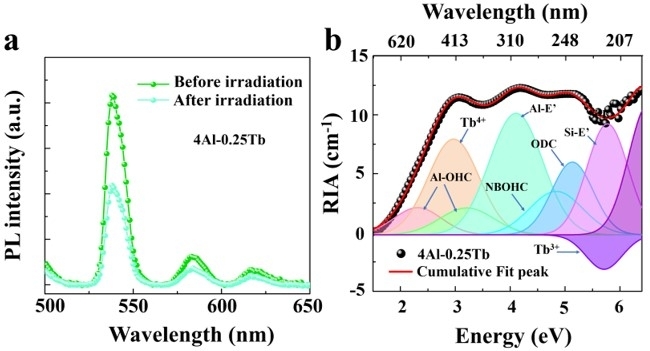Most recently, a research team led by Shanghai Institute of Optics and Fine Mechanics (SIOM), Chinese Academy of Sciences (CAS), has succeeded in revealing the photodarkening mechanisms of Tb3+/Al3+ co-doped silica glasses. The study was published in the Journal of Non-Crystalline Solids on December 18, 2021.
Tb3+ doped visible fiber lasers have found important applications in display techniques, medicine, and national defense. Fluoride glasses are commonly used as a host material for visible fibers due to their low-energy phonon energy.
Unfortunately, high cost, degraded physical properties, and poor mechanical strength have limited their development and further applications. As an alternative, silica fiber show advantages in mature fabrication technique. However, photoinduced darkening limited the power scale of Tb3+ doped silica fiber.
In their experiment, Tb3+/Al3+ co-doped and Al3+ singly doped silica glasses were synthesized as a function of Al3+ ions concentration by mature processing techniques. After X-ray irradiation, the emission intensity and lifetime of Tb3+ at visible wavelength were degraded.
They found that photodarkening of Tb3+ in silica glasses is attributed to the X-ray radiation induced defects and the valence change of Tb3+ ions. The X-ray radiation induced defects including aluminum dangling bond (Al-E’), silicon dangling bond (Si-E’), oxygen vacancy (ODC), aluminum oxygen hole center (Al-OHC), and silicon non-bridge oxygen hole center (NBOHC) show strong absorption at visible wavelength region, leading to the decreased emission intensities of Tb3+ ions.
Moreover, Tb3+ as an electron giver inhibited the formation of hole centers but promoted the formation of electron centers. Besides, the decreased content of Tb3+ ions further reduced their emission intensities.
This research may provide a theoretical model for the selection of host materials for fiber laser operated at visible wavelength.

Figure 1. (a) Photoluminescence (PL) spectra excited at 485 nm of 4Al-0.25Tb sample before and after X-ray irradiation. (b) Gaussian decomposition of radiation induced absorption spectra of 4Al-0.25Tb sample. (Image by SIOM)
Article website:
https://doi.org/10.1016/j.jnoncrysol.2021.121356
Contact:
WU Xiufeng
General Administrative Office
Shanghai Institute of Optics and Fine Mechanics, CAS
Email: xfwu@siom.ac.cn
Web: http://english.siom.cas.cn/